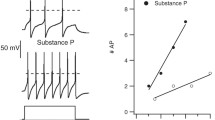Abstract
Morphological peculiarities of neurons that had TRPV1, SP, CGRP, and NF200 markers in thoracic spinal ganglia nerves were studied in 3-month-old rats subjected to chemical deafferentation produced by capsaicin. The obtained results have shown that from 6.5 to 41.3% of ganglion neurons in the control group of animals contain, as a rule, one of the above-mentioned markers. The heterogeneity of nociceptive neurons observed in a control group of rats was also preserved in the capsaicin-treated animals. In both groups, the spinal ganglion TRPV1 neurons were predominant, whereas populations of SP, CGRP, and NF200 neurons formed smaller groups. In each population, sensitivity to capsaicin was shown in the largest neurons, regardless of marker; this sensitivity was pronounced to the greatest degree in the group of TRPV1 neurons.
Similar content being viewed by others
Abbreviations
- SGTN:
-
sensitive of the second thoracic spinal nerve
- CGRP:
-
calcitonin gene-related peptide
- NF200:
-
protein of neurofilaments with mol. mass of 200 kDa
- SP:
-
substance P
- TRPV1:
-
TRPV1-receptors (transient receptor potential vanilloid receptor 1)
References
Akopian, A.N., Sivilotti, L., and Wood, J.N., A Tetrodotoxin-Resistant Voltage-Gated Sodium Channel Expressed by Sensory Neurons, Nature, 1996, vol. 379, pp. 257–262.
Bersenev, V.A., Sheinye spinnomozgovye uzly (Cervical Spinal Ganglia), Moscow: Meditsina, 1980.
Brzozowski, T., Konturek, S.J., Sliwowski, Z., Pytko-Polon’czyk, J., Szlachcic, A., and Drozdowicz, D., Role of Capsaicin-Sensitive Sensory Nerves in Gastroprotection against Acid-Independent and Acid-Dependent Ulcerogens, Digestion, 1996, vol. 57, pp. 424–432.
Bucelli, R.C., Gonsiorek, E.A., Kim, W.-Y., Bruun, D., Rabin, R.A., Higgins, D., and Lein, P.J., Statins Decrease Expression of the Proinflammatory Neuropeptides Calcitonin Gene-Related Peptide and Substance P in Sensory Neurons, Pharmacol. Exp. Ther., 2008, vol. 324, pp. 1172–1180.
Cao, X., Cao, X., Xie, H., Yang, R., Lei, G., Li, F., Li, A., Liu, C., and Liu, L., Effects of Capsaicin on VGSCs in TRPV1-/- Mice, Brain Res., 2007, vol. 1163, pp. 33–43.
Cardenas, C.G., Del, Mar, L.P., Cooper, B.Y., and Scroggs, R.S., 5HT4 Receptors Couple Positively to Tetrodotoxin-Insensitive Sodium Channels in a Subpopulation of Capsaicin-Sensitive Rat Sensory Neurons, Neuroscience, 1997, vol. 17, pp. 7181–7189.
Gold, M.S., Reichling, D.B., Shuster, M.J., and Levine, J.D., Hyperalgesic Agents Increase a Tetrodotoxin-Resistant Na Current in Nociceptors, Proc. Natl. Acad. Sci. USA, 1996, vol. 93, pp. 1108–1112.
Holzer, P., Peptidergic Sensory Neurons on the Control of Vascular Functions Mechanisms and Significance of the Cutaneous and Splanchnic Vascular Beds, Rev. Physiol. Biochem. Pharmacol., 1992, vol. 121, pp. 49–146.
Lai, J., Porreca, F., Hunter, J.C., and Gold, M.S., Voltage-Gated Sodium Channels and Hyperalgesia, Ann. Rev. Pharmacol. Toxicol., 2004, vol. 44, pp. 371–397.
Ma, Q.P., Expression of Capsaicin Receptor (VR1) by Myelinated Primary Afferent Neurons in Rats, Neurosci. Lett., 2002, vol. 319, pp. 87–90.
Masliukov, P.M. and Timmermans, J.-P., Immunocytochemical Properties of Stellate Ganglion Neurons during Early Postnatal Development, Histochem. Cell Biol., 2004, vol. 122, pp. 201–209.
Maslyukov, P.M., Shilkin, V.V., Emanuylov, A.I., and Korzina, M.B., Neurotransmitter Composition of Neurons of the Cranial, Cervical, and Splanchnic Sympathetic Ganglia in Postnatal Ontogenesis, Morfologiya, 2009, vol. 135, no. 1, pp. 30–34.
McLain, R.F. and Weinstein, J.N., orphometric Model of Normal Rabbit Dorsal Root Ganglia, Spine, 1993, vol. 1, pp. 1746–1752.
Piper, A.S. and Docherty, R.J., One-Way Cross-Desensitization between P2X Purinoceptors and Vanilloid Receptors in Adult Rat Dorsal Root Ganglion Neurons, Physiology, 2000, vol. 15, pp. 685–696.
Porseva, V.V., Segmental Differences in the Postnatal Development of Afferent Neurocytes of the White Rat, Morfol. Vedom., 2009, vol. 135, nos. 1–2, pp. 46–48.
Porseva, V.V., Shilkin, V.V., Korzina, M.B., Korobkin, A.A., and Maslyukov, P.M., Changes in the TRPV1-Immunoreactive Neurons in the Sensitive Ganglia of Spinal Nerves of the Rat under the Influence of Capsaicin, Morfologiya, 2011, vol. 139, no. 3, pp. 41–45.
Price, T.J. and Flores, C.M., Critical Evaluation of the Colocalization between Calcitonin Gene-Related Peptide, Substance P, Transient Receptor Potential Vanilloid Subfamily Type 1 Immunoreactivities, and Isolectin B4 Binding in Primary Afferent Neurons of the Rat and Mouse, Pain, 2007, vol. 8, pp. 263–272.
Revenko, S.V., Borovikova, L.V., Borovikov, D.V., and Ermishkin, V.V., Resistance of the Terminal Polymodal C-Units of the Cat Skin to during Mechanical and Heat Stimulation, Byull. Eksp. Biol. Med., 1997, vol. 124, no. 10, pp. 369–371.
Rumyantseva, T.A., Changes in the Neurocytes of Intramural Gastric Ganglia in Desympathetized and Deafferented White Rat, Morfologiya, 2001, vol. 120, no. 4, pp. 82–83.
Somjen, G.G., Sensory Coding in the Mammalian Nervous System, New York: Plenum Pub., 1975.
Suzuki, M., Watanabe, Y., Oyama, Y., Mizuno, A., Kusano, E., and Hirao, A., Localization of Mechanosensitive Channel TRPV4 in Mouse Skin, Neurosci. Lett., 2003, vol. 353, pp. 189–192.
Yasuchika, A., Seiji, O., Kazuhisa, T., Hidetoshi, I., Hideo, D., Tomoyuki, O., Tomoko, S., and Hideshige, M., Expression and Co-Expression of VR1, CGRP, and IB4-Binding Glycoprotein in Dorsal Root Ganglion Neurons in Rats: Differences between the Disc Afferents and the Cutaneous Afferents, Spine, 2005, vol. 30, pp. 1496–1500.
Yoshimura, N., Erdman, S.L., Snider, M.W., and de Groat, W.C., Effects of Spinal Cord Injury on Neurofilament Immunoreactivity and Capsaicin Sensitivity in Rat Dorsal Root Ganglion Neurons Innervating the Urinary Bladder, Neuroscience, 1998, vol. 83, pp. 633–643.
Author information
Authors and Affiliations
Corresponding author
Additional information
Original Russian Text © V.V. Porseva, 2012, published in Tsitologiya, 2012, Vol. 54, No. 12, pp. 887–891.
Rights and permissions
About this article
Cite this article
Porseva, V.V. Characteristics of capsaicin-sensitive afferent neurons of spinal nerve ganglia. Cell Tiss. Biol. 7, 149–153 (2013). https://doi.org/10.1134/S1990519X13020119
Received:
Published:
Issue Date:
DOI: https://doi.org/10.1134/S1990519X13020119



